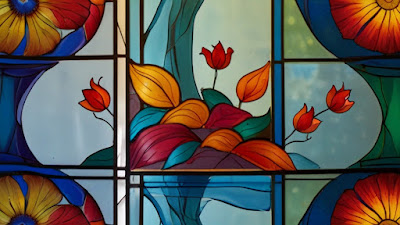The Art of Illumination: A Guide to Glass Painting
Glass painting, the art of adorning glass surfaces with vibrant designs, has captivated artists for centuries. From the breathtaking stained glass windows of medieval cathedrals to the delicate floral motifs adorning Victorian tableware, this art form transcends mere decoration, transforming light itself into a storytelling medium. Whether you're a seasoned artist or a curious beginner, this comprehensive glass painting guide will illuminate the wonders of glass painting, equipping you with the knowledge and techniques to embark on your own creative journey.
A Dazzling History: Unveiling the Origins of Glass Painting
The exact origins of glass painting remain shrouded in the mists of time. Early examples, dating back to Ancient Egypt and Rome, involved gilding or enamelling glass for decorative purposes. However, the technique we recognize today is believed to have flourished in Europe during the Middle Ages.
Stained glass windows became a signature feature of Romanesque and Gothic architecture. Skilled artisans meticulously crafted narratives and religious iconography using coloured glass fragments held together by lead cames (strips). These luminous masterpieces not only bathed interiors in a kaleidoscope of colours but also served as educational tools for a largely illiterate population.
The Renaissance ushered in a new era of glass painting, with artists like Albrecht Dürer and Michelangelo creating stunning designs for stained glass windows. Techniques became more sophisticated, with enamelling and silver staining gaining prominence. Glass painting also transitioned beyond religious settings, adorning secular buildings and personal possessions.
The Victorian era witnessed a surge in the popularity of domestic glass painting. Delicate floral and geometric patterns graced everything from drinking glasses and vases to mirrors and picture frames. The invention of commercially produced enamel paints further democratized the art form, allowing anyone to try their hand at this captivating craft.
Today, glass painting remains a vibrant and versatile art form. Artists continue to explore traditional stained glass techniques while pushing boundaries with innovative materials and methods. From contemporary stained glass installations gracing modern buildings to whimsical hand-painted drinking glasses, the possibilities are endless.
Gearing Up: Essential Tools and Materials for Glass Painting
Embarking on your glass painting adventure requires gathering some key tools and materials:
- Glass: The canvas for your artwork! Choose smooth, transparent glass surfaces like picture frames, drinking glasses, vases, or pre-cut glass panels specifically designed for painting. Consider the size and shape of the glass for your desired design.
- Glass Paint: Opt for high-quality, solvent-based glass paints specifically formulated for adhesion to glass surfaces. These paints come in a vast array of vibrant colours, allowing you to bring your vision to life.
- Brushes: Select a variety of fine-tipped brushes for detailed work and broader brushes for filling larger areas. Opt for synthetic brushes specifically designed for use with glass paints.
- Paint Mediums: Explore mediums like thinners for creating washes and extenders for stretching your paint supply. Experiment with different mediums to achieve desired effects.
- Outlining Tools: Use a glass paint marker, fine-tipped permanent marker, or artist's pen to create outlines for your design. Ensure the chosen marker is compatible with glass paint and can be easily removed with a solvent.
- Other Supplies: Keep rubbing alcohol or a glass cleaner handy for degreasing your glass surface before painting. Cotton swabs are useful for removing paint mistakes, and stencils can add a touch of uniformity for beginners.
Mastering the Craft: A Step-by-Step Guide to Glass Painting
Now that you're armed with the necessary tools, let's delve into the exciting process of glass painting:
- Preparation is Key: Clean your glass surface thoroughly with rubbing alcohol or a glass cleaner to remove any dirt, grease, or residue that might hinder paint adhesion. Allow the glass to dry completely before proceeding.
- Design Your Masterpiece: Sketch your design on paper beforehand, especially for intricate patterns. You can freehand the design directly onto the glass or use stencils for a simplified approach. For beginners, using a pre-printed design you trace onto the glass is a great way to start.
- Outline Your Vision: Using your chosen outlining tool, carefully trace your design onto the clean, dry glass surface. Allow the outline to dry completely before applying paint.
- Time to Paint!: Pour a small amount of paint onto a palette or disposable dish. Begin by filling in smaller areas with your chosen colours. Layer thin coats of paint for better control and opacity. Use a variety of brushstrokes depending on the desired effect.
- Let There Be Light!: After each layer of paint dries completely, hold your artwork up to the light to check for any missed spots or areas needing touch-ups. This allows you to ensure even coverage before adding subsequent layers.
- Bringing it All Together: Once the painting is complete, allow the final layer
Once all the painting is complete, allow the final layer to dry thoroughly, following the manufacturer's instructions for curing time. With a sense of pride, hold your creation up to the light and admire the way the colors dance and transform with each ray that passes through. Display your masterpiece with joy, or gift it to a loved one, knowing you've breathed life and vibrancy into a simple glass surface through the art of glass painting.

